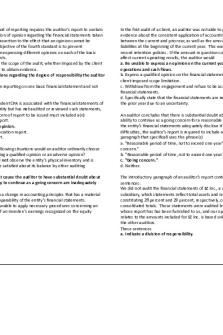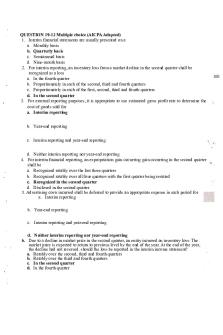Accounting 4 PDF

| Title | Accounting 4 |
|---|---|
| Course | Principles Of Financial Accounting |
| Institution | University of North Florida |
| Pages | 5 |
| File Size | 89.1 KB |
| File Type | |
| Total Downloads | 66 |
| Total Views | 161 |
Summary
Accounting Notes. forGill...
Description
The statement of retained earnings reports similar information, including dividends Since revenue, expense, and dividends accounts record information separately for each period, they must start each period with zero balances To close revenue and expense accounts, transfer their balances to the Income Summary account Income Summary is a temporary account only used for the closing process: it contains a credit for total revenues (and gains) and a debit for totally expenses (and losses) Its balance equals net income or net loss and it is transferred to retained earnings Next the dividends account balance is transferred to retained earnings. After these closing entries are posted, the revenue, expense, dividends, and income summary accounts have zero balances. These accounts are then said to be Closed or Cleared 1. Close income statement credit balances 2. Close income statement debit balances 3. Close income summary account 4. Close dividends account
Step 1: Close Credit Balances in Revenue Accounts to Income Summary The first closing entry transfers credit balances in revenue (and gain) accounts to the Income Summary account. You bring accounts with credit balances to zero by debiting them This entry closes revenue accounts and leaves them with zero balances The accounts are now ready to record revenues when they occur in the next period. The credit entry into the Income Summary equals total revenues for the period Step 2: Close Debit Balances in Expense Accounts to Income Summary 2 closing entry transfers debit balances in expense (and loss) accounts to the Income Summary account bring expense accounts debit balances to zero by crediting them with a balance of zero, these accounts are ready to record expenses for the next period. Step 3: Close Income Summary to Retained Earnings After steps 1 and 2, the balance of Income Summary is equal to December’s net income. 3 closing entry transfers the balance of the Income Summary account to retained earnings This entry closes the income summary account The income summary account has a zero balance after posting this entry it continues to have a zero balance until the closing process again occurs at the end of the next period (if a net loss occurred because expenses exceeded revenues, the third entry is reversed: debit retained earnings and credit Income Summary). Step 4: Close Dividends Account to Retained Earnings The fourth closing entry transfers and debit balance in the dividends account to retained earnings nd
rd
This entry gives the dividends account a zero balance, and the account is now ready to record next period’s dividends This entry also reduces the retained earnings balance to the amount reported on the balance sheet Temporary accounts have ending balances equal to zero
Post-Closing Trial Balance: is a list of permanent accounts and their balances from the ledger after all closing entries have been journalized and posted Lists balances for all accounts not closed Accounts comprise a company’s assets, liabilities, and equity, which are identical to those in the balance sheet. The aim of a post closing trial balance is to verify that: 1. total debits equal total credits for permanent accounts 2. All temporary accounts have zero balances Accounting Cycle: the steps in preparing financial statements. 10 steps starting with analyzing transactions and ending with a post-closing trial balance or reversing entries 1-3 occur regularly as a company enters into transactions 4-9 are done at the end of a period Reversing entries in step 10 are optional 4, 6, and 9 are done on a worksheet unclassified Balance Sheet: broadly groups accounts into assets, liabilities, and equity. Classified Balance Sheet: organizes assets and liabilities into subgroups that provide more information to decision makers Classified balance sheet contains o Current assets o Noncurrent assets o Long term investments o Plant assets o Intangible assets o Current liabilities o Noncurrent liabilities o Equity Current assets are expected to come due (either collected or owed) within one year of the company’s operating cycle Operating Cycle: is the time span from when cash is used to acquire goods and services until cash is received from the sale of goods and services Length of a company’s operating cycle depends on its activities For a service company, the operating cycle is the time span between o 1. Paying employees who perform the services o 2. Receiving cash from customers For a merchandiser selling products, the operating cycle is the time span between o 1. Paying suppliers for merchandise o 2. Receiving cash from customers
Balance sheet lists current assets before noncurrent assets and current liabilities before noncurrent liabilities This consistency in presentation allows users to quickly identify current assets that are most easily converted to cash and current liabilities that are shortly coming due. Items in current assets and current liabilities are listed in the order of how quickly they will be converted to, or paid in, cash Current Assets: cash and other resources that are expected to be sold, collected, or used within one year or the company’s operating cycle, whichever is longer
ex:
short-term investments accounts receivable o short-term notes receivable o goods for sale (called merchandise or inventory) o prepaid expenses Prepaid expenses likely include items such as o Prepaid insurance o Prepaid rent o Office supplies o Store supplies Prepaid expenses are usually listed last because they will not be converted to cash, instead they are used o o
Long-Term Investments: Notes receivable and investments in stocks and bonds are longterm assets when they are expected to be held for more than the longer of one year or the operating cycle. Land held for future expansion is a long-term investment because it is not used in operations. Plant assets: tangible assets that are both long-lived and used to produce or sell products and services Ex: o Equipment o Machinery o Buildings o Land Order listing for plant assets is most liquid to least liquid such as equipment and machinery to buildings and land Intangible Assets: long term resources that benefit business operations but lack physical form. Ex: o Patents
Trademarks o Copyrights o Franchises o Goodwill Value comes from privileges or rights granted to or held by the owner Jarden: reports intangible assets, including goodwill, which is roughly 50% of its total assets. Its intangibles include trademarks, patents, and licensing agreements. o
Current Liabilities: obligations due to be paid or settled within one year or the operating cycle, whichever is longer. They are usually settled by paying out cash Current liabilities often include: o Accounts payable o Notes payable o Wages payable o Taxes payable o Interest payable o Unearned revenues Any portion of a long-term liability due to be paid within one year or the operating cycle, whichever is longer, is a current liability. Unearned revenues are current liabilities when they will be settled by delivering products or services within one year or the operating cycle, whichever is longer Current liabilities are reported in the order of those to be settled first Long-term Liabilities: obligations not due within one year or the operating cycle, whichever is longer. Common long term liabilities Notes payable Mortgages payable Bonds payable Lease obligations If a company has both short and long term items in each of these categories, they are commonly separated into two accounts in the ledger Equity is the owner’s claim on assets. For a corporation, the equity section is divided into two main subsections, contributed capital (common stock) and retained earnings Profit Margin: return on sales./ratio A useful measure of a company’s operating results is the ratio of its net income to net sales An important use of financial statements is to help assess a company’s ability to pay its debts in the near future Such analysis affects decisions by suppliers when allowing a company to buy on credit It also affects decisions by creditors when lending money to a company including loan terms such as o interest rate o due date o collateral requirements
it can also affect a manager’s decisions about using cash to pay debts when they come due Current Ratio: one measurement of a company’s ability to pay its short-term obligations. Current assets/current liabilities = Current Ratio
an alternative method is to record all prepaid expenses with the debits to expense accounts if any prepaids remain unused or unexpired at the end of an accounting period, then adjusting entries must transfer the cost of the unused portions from expense accounts to prepaid expense (asset) accounts The financial statements are identical under either method, but the adjusting entries are different An alternative method is to record all unearned revenues with credits to revenue accounts If any revenues are unearned at the end of an accounting period, then adjusting entries must transfer the unearned portions from revenue accounts to unearned revenue (liability) accounts This alternative method is acceptable. The adjusting entries are different for these two alternatives, but the financial statements are identical. After adjusting entries are posted, the two alternatives give identical results WORK SHEET AS A TOOL
Work Sheet: a document that is used internally by companies to help with adjusting and closing accounts and with preparing financial statements
Aids the preparation of financial statements Reduces the risk of errors when working with many accounts and adjustments Links accounts and adjustments to their impacts in financial statements Helps in preparing interim (monthly and quarterly) financial statements when journalizing adjusting entries is postponed until year-end Shows the effects of proposed or “what-if” transactions
How to use a worksheet: When a worksheet is used to prepare financial statements, it is constructed at the end of a period before the adjusting process 2 columns, each for the unadjusted trial balance, the adjustments, the adjusted trial balance, the income statement, and the balance sheet...
Similar Free PDFs

Accounting 4
- 5 Pages

Ch 4 - International Accounting
- 9 Pages

Advanced Financial Accounting-4
- 3 Pages

Accounting Principles - Chapter 4
- 98 Pages

Accounting Principles chapter 4
- 13 Pages

Brainscape 4 - Accounting
- 7 Pages

4 - Accounting Theories
- 4 Pages

Topic-1-4 - Advance Accounting
- 6 Pages

Chapter 4 - Answer - Cost Accounting
- 18 Pages

Accounting Study Guide Test 4
- 2 Pages

Horngren’s Cost Accounting CH 4
- 70 Pages
Popular Institutions
- Tinajero National High School - Annex
- Politeknik Caltex Riau
- Yokohama City University
- SGT University
- University of Al-Qadisiyah
- Divine Word College of Vigan
- Techniek College Rotterdam
- Universidade de Santiago
- Universiti Teknologi MARA Cawangan Johor Kampus Pasir Gudang
- Poltekkes Kemenkes Yogyakarta
- Baguio City National High School
- Colegio san marcos
- preparatoria uno
- Centro de Bachillerato Tecnológico Industrial y de Servicios No. 107
- Dalian Maritime University
- Quang Trung Secondary School
- Colegio Tecnológico en Informática
- Corporación Regional de Educación Superior
- Grupo CEDVA
- Dar Al Uloom University
- Centro de Estudios Preuniversitarios de la Universidad Nacional de Ingeniería
- 上智大学
- Aakash International School, Nuna Majara
- San Felipe Neri Catholic School
- Kang Chiao International School - New Taipei City
- Misamis Occidental National High School
- Institución Educativa Escuela Normal Juan Ladrilleros
- Kolehiyo ng Pantukan
- Batanes State College
- Instituto Continental
- Sekolah Menengah Kejuruan Kesehatan Kaltara (Tarakan)
- Colegio de La Inmaculada Concepcion - Cebu




